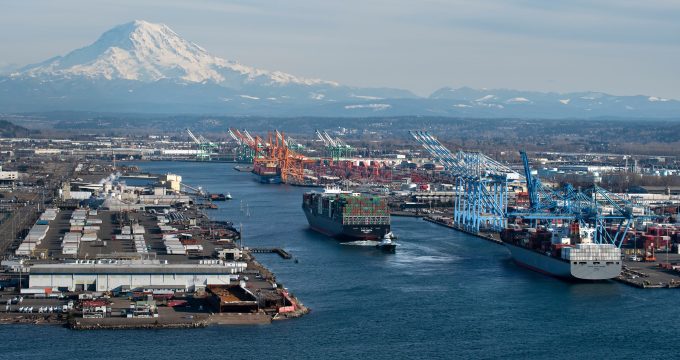Looks like rain: Panama Canal Authority eyes return to normal service
The Panama Canal could be back at nearly full capacity in time for this year’s ...

The Northwest Seaport Alliance (NWSA) can see light at the end of the congestion tunnel.
At the end of last year, vessel unloading had slowed due to the festive holiday and icy weather, but terminals are back to handling multiple ships a day.
And the number of vessels waiting for berth space was down to two or three, mid-week.
Rail flows have been smooth since the two Class I operators that serve the port complex managed to clear their backlogs, but there is still some congestion at the main terminals, said NWSA executive director John Wolfe.
The port took a major step forward in the battle against congestion with the return of Terminal 5 into action at the end of last week. The former Hanjin terminal at Tacoma handled its first vessel in two years after closing for refurbishment in 2019.
Its return marks the halfway point in its overhaul; the first phase of the $500m project restored and modernised one of its two berths and installation of four super-post-panamax cranes and improvements to the rail yard, boosting the port’s annual capacity by 250,000-300,000 container lifts.
The second phase, centred around refurbishment of the other berth, is expected to be completed by the end of Q1 23. This will raise the terminal’s capacity to over 500,000 container lifts a year.
MSC was the first carrier to use the refurbished facility, diverting a vessel from Terminal 18. The carrier plans to split its transpacific service calls at the port, with two to be handled at Terminal 5.
While this helps with vessel handling and rail traffic, it has not had an immediate impact on the container pile-up at the port complex.
“It will take a while to flush out the backlog,” said NWSA COO Tom Bellerud.
The NWSA has used part of Terminal 5 and locations near the ports for storing empty and, to a lesser extent, import and export containers. In addition, it has worked with inland ports in North Dakota and Idaho. These measures have taken the edge off the congestion, but could not completely avoid a build-up of boxes at the main terminals, said Mr Wolfe, who added: “We’re looking for additional space.”
A property of over 8 ha within the port of Tacoma, in close proximity to two terminals, will be developed to create additional yard space. This may be used by a third-party operator to run a common-user facility, or one of the neighbouring terminals could expand into this space, said Mr Bellerud.
And the port has some fresh funds to tap into for expansion. The latest round of federal port funding through the Maritime Administration’s Port Infrastructure Development Programme will send a $15.7m grant its way, meant for construction of an off-dock container facility.
Altogether, the programme dispenses $241m to 25 port projects. Washington’s largesse has eased frustration on the west coast over funding vis-a-vis competitors north of the border. A study commissioned and published last year by ports in Washington State and California claimed Canadian ports received more than double their federal funding in the 2016-2020 period.
“It is clear to us that the federal government has an opportunity to make more federal money available for these national strategic assets… and it’s clear that during these times, when the supply chain is failing, how critical it is for the federal government to continue to invest in the US supply chain,” Mr Wolfe said.
Comment on this article